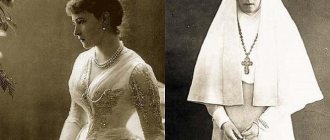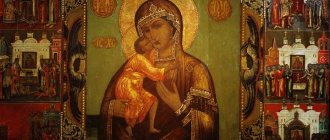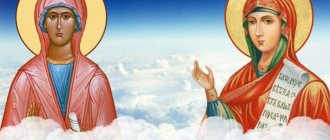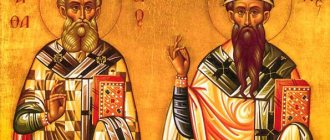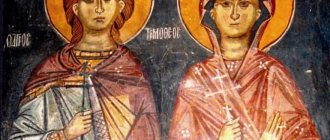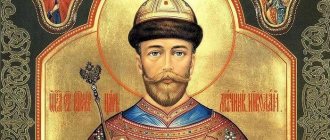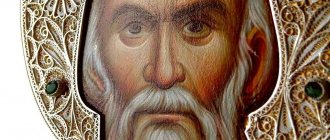Veronica's name day according to the church calendar
Since Angel Day is a special holiday for all those who believe in the Almighty, Veronica’s name day is no exception.
According to church regulations, Veronica's name day occurs several times a year, but there can only be one Angel Day - the one closest to her date of birth.
In any case, this euphonious female name has an interesting interpretation, history and patrons, which will be of interest to all Veronicas and those who would like the name to accompany their daughter all her life.
Saint Veronica lived during the earthly life of Jesus Christ
We can learn very little from the life of Saint Veronica. The righteous woman lived during the earthly life of Jesus Christ. For about twelve years she suffered from a very serious illness, female bleeding. It greatly debilitated her condition, and none of the doctors she contacted could help her.
During the years of her serious illness, she exhausted all her property and fell into an even more terrible and deplorable state. On top of everything else, she was an outcast among her people - according to the law, Jews cannot touch a woman in uncleanness.
Veronica was already completely desperate and had lost all hope for the meaning of her existence, realizing that she would never be able to recover from this terrible disease.
One day she was walking through the city and saw the Lord passing by. Her heart flared violently. At that time, she had only heard a little about Jesus Christ, and there was a lot of controversy about him. But she firmly believed that he was the same Messiah, Christ.
A certain thought arose in her head, and she began to weigh the pros and cons. And in the end I decided to take a desperate but daring step. After all, for this she could have been stoned by her own people.
Veronica had one intention: to carefully approach the Savior and touch the hem of His robe
She wanted this to be healed and decided to let it be.
But she believed in her heart that if she touched His clothes, she would definitely receive healing from her illness. She walked forward. Squeezing through the huge crowd that surrounded the Savior, Veronica came up from behind and touched the hem of his robe.
(Mark 5:29-31)
“And immediately her source of blood dried up, and she felt in her body that she was healed of her illness. At the same time, Jesus, feeling within Himself that power had gone out of Him, turned among the people and said: Who touched My garment? The disciples said to Him: You see that the people are crowding You, and you say: Who touched Me? But He looked around to see the one who did it..."
From that moment on, Veronica became completely healthy. After which she became a Christian. She always tried to be where the Lord passed.
In honor of her healing, Veronica decided to order a statue, but it has not survived to this day. What exactly this statue was, no one knows, it was never found. Perhaps we can assume that it was a statue of our Lord Jesus Christ himself.
Veronica: the meaning of the name according to the church calendar
The name Veronica is known to us from biblical stories. It was given to a woman from Jerusalem who carefully helped Jesus as he carried the cross: she shared with him a headscarf.
Therefore, for religion, both Orthodox and Catholic, this name is given a special meaning.
The roots of the name Veronica go back to the times of ancient Greece, and the meaning can be divided into two parts. The first in translation is “bring”, and the second is “victory”; it turns out that Veronica is the bringer of victory. It was the goddess Nike who was worshiped and revered by the warriors, whom she blessed for success in battle.
Many historians are inclined to think that the name Veronica goes back to the name of Pherenik, the wife of the ruler of Egypt from the Ptolemaic dynasty.
Many may find this article useful about when Olga’s name day is.
aledr
Happy holiday to everyone involved. The website www.calend.ru tells us the following story: Saint Veronica, with whose memory the Image of the Suffering Savior Not Made by Hands is associated, became one of the most popular national saints, despite the fact that some church authorities and critical studies spoke out against the historical authenticity of Veronica and her legend. Let's try to restore the events. Betrayed and condemned to martyrdom, Jesus Christ walked to Mount Calvary, carrying His cross to be crucified. The procession was surrounded by a crowd accompanying the Savior to His suffering on the cross. Veronica merged with the human sea and followed Christ.
Icon of Saint Veronica
Exhausted, Jesus fell under the weight of the cross, and Veronica, taking pity on Him, ran up to Him, gave Him water to drink and gave Him her cloth to wipe the sweat from his face. Returning home, Veronica discovered that the holy face of the Savior was imprinted on the fabric. This cloth of St. Veronica eventually found its way to Rome and became known here under the name of the Image Not Made by Hands... In the Middle Ages, almost every church had an image of Veronica with her sudarium (sweat cloth). Veronica also took a strong place in the mysteries of the Middle Ages and is still the main figure of the sixth station of the Way of the Cross. It is believed that the name Veronica is a distortion of the Latin vera icon (“true image”) - the so-called “Veronica’s cloth”, distinguishing it from other images of Christ. The story of Saint Veronica first appears in the apocryphal Acts of Pilate, dating back to the 4th or 5th century. The image and deeds of Saint Veronica have led to her being revered as the patroness of photographers and photography. Therefore, amateurs and photography professionals celebrate this day as photographer’s day. World Photography Day is celebrated annually in many countries on August 19th. On this day in 1839, the French government, which bought the patent of the French chemist and inventor Louis Jacques Mandé Daguerre (Daguerre) on a method for producing a print (daguerreotype), made the discovery of the daguerreotype public knowledge of the world community - in other words, a wide range of ordinary people learned about the invention of the prototype of photography.
Religious reading: Martyr Veronica prayer to help our readers.
>Orthodox icons and prayers
Information site about icons, prayers, Orthodox traditions.
Veronica angel day orthodox
The name Veronica has various variants: abbreviated ones - Vera, Nika, Vika, endearing ones - Nikulya, Verunchik, Ronyushka, and that’s not all. But even with such “personalized” wealth, there is only one church choice, and the girl will be given only the name Veronica at baptism.
According to the month, the day of the Angel is chosen as close as possible to the date of birth. As for the holiday organization, it will be somewhat different than on a birthday.
On this day, only the closest ones are invited, who are set up for a calm celebration with family with lighted candles and traditional cuisine.
Veneration in Orthodoxy
The Russian Orthodox Church celebrates the feast day of Saint Veronica on July 25. Traditionally, on this day, at the morning service, a troparion is read at the icon of the saint. Saint Veronica is also the protector of all photographers.
There is an icon of Saint Veronica, on which she is depicted with a scarf with the face of Christ appearing on it. The story associated with the face emerging on the plateau is as follows. Having learned that Christ was in danger of execution, the holy righteous woman went to Jerusalem, where in those days the Easter holiday was celebrated.
Having made her way through the huge crowd, she saw that the exhausted Christ was carrying a huge cross. Veronica rushed through the crowd to the Lord and, giving him water, wiped the face of Christ with her handkerchief, despite the attacks of the guards and threats to put her to death.
What is Veronica's name day?
Saint Veronica is revered in Orthodoxy and Catholicism. But with the same interpretation of the events of the biblical plot, the dates of the name day differ.
In accordance with the church plan of the Catholic world, the day on which the woman who experienced severe torment under the name Veronica is remembered is July 12. She is the patron of photographers, since the head covering has acquired the image of a holy face.
According to Orthodox canons, Veronica’s special day takes place three times: July 20 - in honor of the martyr Veronica, the 25th of the same month - righteous Veronica, October 17 - the day of remembrance of the martyr Veronica of Edessa.
Holy Martyr Veronica
Regarding the martyr Veronica, accurate information about the exact origin of the woman and the specifics of her torment has not reached us. Nevertheless, Orthodoxy honors her memory on July 30th for her strong faith in Jesus on July 30th.
It turns out that the memorial days of these two Veronicas are not far from each other in calendar terms. Therefore, parents have a choice of name day if their daughter's birthday falls between these dates.
Saint Veronica - an example of Christian piety
According to Demetrius of Rostov, Saint Veronica suffered with her sister and mother during the reign of Emperor Diocletian. This happened in 304. After this, Constantine signed an edict stating that everyone could convert to Christianity at their own discretion.
But the number of executions, despite the new law, still did not change, and Christians continued to be persecuted by the pagans. However, during Veronica’s life, persecution was still allowed, and she and her family had to flee from Syrian Antioch to the city of Edes. Therefore, now the holy martyr is called Edessa.
But Saint Veronica was captured by soldiers and sent back to her homeland. However, on the way, Veronica, her sister and mother, having prayed to God, accepted the crown of martyrdom by jumping into the river. Thus, they deprived the cruel pagans of the pleasure of watching them be tortured.
Veronica's Memorial Day in Orthodoxy is celebrated on July 15. In the biography of this saint there is an indication of the acquisition of the Miraculous Image of the Savior. Despite the fact that the day of memory of Veronica is mentioned in the Orthodox calendar, it is not indicated in the official calendar of the Russian Orthodox Church.
Tradition says that Saint Veronica once touched the hem of the Savior’s robe and received healing. The Gospel of Matthew tells about this incident. From the biography of the saint it is known that when Christ was led to Golgotha, she wiped His blood-stained face with a handkerchief, and the image of the Savior remained on the cloth.
There is a version that she was one of Christ’s disciples and, not being able to constantly accompany Him, commissioned the artist to create an image of Jesus, and this image began to have the gift of healing. With his help, Emperor Tiberius received healing.
According to Christian tradition, Saint Veronica is considered a pious Jew. There is speculation that her name comes from the Latin "vera icon", which means "genuine image". The saint's lifestyle became an example of high piety and deep faith for Christians. She is revered as the patroness of photographers - this was due to the imprint of the face of Jesus Christ on her scarf.
Veronica holding a handkerchief is depicted in icons and paintings among the crowd of evil people who surrounded Christ before His martyrdom on the cross. The appearance of the pious maiden among the tormentors is distinguished by the subtlety and nobility of her facial features.
The life of the holy martyrs and martyrs who suffered for Christ was and remains an example of piety for believers. The Church honors the memory of such people, calling us to be like them, to strive with all our hearts for God, to have such faith that will help us in the future to enter the Kingdom of Heaven.
Veronica of Edessa
And the other Veronica martyr is also known under the name Virinea. During the reign of Diocletian, the woman, as well as her mother and sister, had to flee from their hometown to Edessa. Torture and mockery of believers, their execution was the norm of that time, hence the Christian heroine was called Edessa.
However, the existence of these representatives of the fairer sex quickly lost their freedom. Those who were pursuing the women overtook them and transported them to where they had fled. Veronica's family could not tolerate such a turn of fate. The women waited until the enemies were distracted and turned to Christ, throwing themselves into the river.
Their suffering was not small, but freedom was preserved. And on October 17, the church honors the memory of Virinea, who paid with her life for her unshakable faith in God.
patron saints
Life of Saint Virinea (Veronica) of Edessa
Icon of the Holy Martyr Veronica (Verinea) of Edessa
According to the life of the holy martyr Veronica as presented by Dmitry of Rostov, she, along with her sister and mother, suffered during the end of the reign of Emperor Diocletian, around 304. Just a year later, the holy Equal-to-the-Apostles King Constantine signed an edict, which granted the right of free conversion to Christianity to anyone who wished, which, in fairness, it should be noted, did not particularly reduce the number of tortures and executions of Christians by local administrators - adherents of paganism. But in 304, the persecution of Christians was officially resolved, and Saint Veronica (Virinea), together with her sister and mother, trying to escape from their persecutors, went from Syrian Antioch to the city of Edes. Therefore, the full magnification of the saint is listed as: holy martyr Veronica (Virinea) of Edessa. But their hopes were not justified; in Edessa the holy martyrs were captured by soldiers and sent back to Antioch. The soldiers failed to deliver the holy martyrs to their homeland; in the middle of the journey, they accepted death by water in the name of the Lord, depriving the pagan judges of the pleasure of watching the torture of their bodies. Having waited for the soldiers escorting them to sit down to dinner, Saint Veronica, her mother Domnina and sister Proskudi, dressed in their best clothes, prayerfully turned to the Lord and threw themselves into the river, thereby winning themselves the crown of martyrdom. The legend about the holy righteous Veronica is also widely known, whose life story is closely connected with the discovery of the Image of the Savior Not Made by Hands. Despite frequent references to the fact that the day of remembrance of Righteous Veronica is celebrated in the Orthodox Church on July 12/25, the official publications of the Moscow Patriarchate say nothing about her; for some reason the saint is not included in the official calendar of the Russian Orthodox Church. According to legend, righteous Veronica, touching the hem of the Savior’s robe, received healing. This event is described in the Gospel of Matthew, chapter 9 (20-22). It is also believed that the biography of this saint is closely connected with the story of the acquisition of the Miraculous Image. When Christ was led to Calvary, Veronica wiped the sweat and blood stained face of Jesus with a cloth, and it was reflected on the material. There is another version of this legend, according to which Veronica was a student of the Savior, but she could not accompany him all the time, then she decided to order a portrait of the Savior from the painter. But on the way to the artist, she met the Savior, who miraculously imprinted his face on her plate. Veronica's cloth was endowed with the power of healing. With its help, the Roman Emperor Tiberius was cured. The meaning of the icon Here we look at the image of Saint Virenea of Edessa, about whom the Life says that she, with her mother and sister, threw herself into the river in the name of Christ, so as not to allow the tormentors to mock their bodies. On the one hand, they committed suicide, and this is a sin. But why then did Saint John Chrysostom speak of their action with great respect? In modern society, we have forgotten the meaning of such a concept as female honor. Death was the best way out to avoid desecration of honor, and under such circumstances could in no way be considered a crime before the Lord. The image of the saint reminds us of a way of life that has served as the moral support of society for centuries.
Patron of the name Veronica for girls
The guardian angel for the girl with the described name is Veronica the Righteous, which comes to us, as already mentioned, from the biblical pages. In the time of Christ, a woman was known who suffered for many years from loss of blood. For more than ten years, she spared neither effort nor money on healers, but there was no proper result.
And now the woman learns about possible magical healing, thanks to the touch of Christ. Then, while Jesus was moving to the place of his execution, she decided to follow him in the crowd.
When Christ falls due to the weight of the cross, the woman gives him water from a jug and wipes his sweat with a handkerchief. And a miracle happens: the disease began to recede upon touching the Saint. All the years of suffering disappeared in an instant. And upon returning home, the woman notices the presence of the silhouette of Jesus on the scarf with which the Saint’s face was wiped. And since then, such a fragment has been classified as an icon not made by hands.
After her amazing recovery, our heroine installs the figure of Christ near her place of residence, and the growing grass near the statue becomes a magical medicine for other representatives of the female race.
Today, on the day of the Angel of Veronica the Righteous, July 25, the church also remembers the emergence of a miraculous masterpiece. They also say that the heroine of the story had a different name before the healing, and then became Veronica.
Saint Veronica in Catholicism
In the Catholic tradition, there is a version that Saint Veronica was a pious Jew. She followed the Savior throughout His journey to Calvary. Under the weight of the cross, Christ bowed to the ground. Then Veronica wiped the Lord's face from blood and sweat with her linen scarf. The face of the Savior was displayed on the board. In Catholicism, the “Veronica Plaque” is considered authentic and is kept in St. Peter's Basilica in Rome. Catholics recognize this particular image as the miraculous image of the Savior.
The first mention of Saint Veronica dates back to the 4th-5th centuries, found in the apocryphal “Acts of Pilate”. Veronica's meeting with Christ is described only in medieval legends and recorded in the Bible of Roger of Argenteuil (c. 1300).
Meaning of the name
Some scholars believe that this name originated from the wife of the Egyptian ruler of the Ptolemaic dynasty, whose name was Fereniki. From here came two variations of origin. If the literal translation of the name from Greek is “bringing victory,” then in Latin it means a completely different meaning—“true image.”
Historians believe that this discrepancy in meaning depends on pronunciation. We find the roots of the name in ancient Greece. Veronica was considered the one who brings victory.
Hence, a goddess with that name was worshiped by warriors to receive blessings for success in battle. Veronica has become known since the appearance of biblical stories: a woman from Jerusalem helps Jesus and shares a headscarf with him.
Therefore, religion has a special attitude towards such a name. In everyday life, Veronica can be called differently: Nika, Vera, Vika, Nikulya. Saints prefer strict forms: Berenice, Ferenika. However, there will be no options at baptism, and the girl will only be named Veronica.
To celebrate the Laziness of an angel, those closest to you are invited. The celebration is held in a narrow circle: traditional dishes are prepared and candles are lit.
Church tradition
Little information has been preserved about the life of Saint Veronica. According to the text of the Gospel, it is known that Saint Veronica (Virinea) came from Caesarea. She was a rather rich woman and respected among the townspeople. Some sources say that it was Veronica who was the nurse of Tiberius the Emperor, but this fact has not been documented.
In the Orthodox faith, this saint is mentioned as the bleeding one and one biblical legend is associated with her, which is not in the canonical text of the Holy Scriptures in its entirety.
It is known that when the girl turned 12 years old, she began to suffer from a very serious disease that affects only women. This bleeding did not stop, and none of the healers could help Veronica. Because of this disease, both the financial condition and the estate where the woman lived became deplorable over time.
But this was not the most terrible thing for her, because according to Jewish law, a woman in uncleanness was considered an outcast, and was even sometimes accused of having connections with the devil himself. Having lost all hope of healing, Veronica, wandering around the city one day, met Christ, and her heart immediately recognized her God.
And although in those days many did not believe in Jesus and considered him a fraudster, this woman had firm faith that the Lord himself was before her. Veronica decided, at the risk of being stoned by the townspeople who despised her, she realized that Jesus could heal her and so she only lightly touched Christ’s clothes.
Christ felt a certain power emanating from him and asked the crowd gathered around him: “Who touched me?” And although those around were sure that the touch was accidental, because people stood in a tight ring around the Teacher, Jesus continued to peer into the crowd, wanting to see the woman who had received healing.
Veronica, indeed, was freed from the illness that had tormented her for many years and since then has become even stronger in her faith and tirelessly followed Christ, her Savior.
On a note! Using all her remaining funds, Veronica decided to order a sculpture depicting Christ, but the statue has not survived to this day and no information about it has survived.
When is Angel Day?
Saint Veronica is revered in Orthodoxy and Catholicism, hence the dates of name days differ. Catholics consider July 12th to be Angel Day. In Orthodoxy, a special day for Veronica occurs three times: July 20 and 25, as well as October 17. In the summer months, righteous Veronica is venerated, and in the fall - the day of remembrance of the martyr Veronica of Edessa.
Veronica the Righteous (July 25)
Nika's guardian angel is Veronica the Righteous, known to us from the pages of the Bible. The woman suffered from blood loss for many years. To overcome the disease, she spares no time, effort and money, but all the efforts of the unfortunate woman come to naught. And then the woman learns about the possibility of magical healing: it is necessary for Christ to touch her.
As Jesus moves to the place of his execution, she decides to follow him in the general crowd. Christ falls: the cross turns out to be very heavy. At this time, the woman gives him a drink of water and wipes the sweat from Jesus’ face with her handkerchief.
A miracle happens - the disease begins to disappear, because the woman touched the saint. Returning home, she discovers the silhouette of Jesus on that same scarf. From then on, such a fragment will be considered a miraculous icon.
The heroine of the story will install a figure of Christ not far from her: the grass growing nearby will be considered a medicine for other similar sufferers. Many sources believe that initially the woman had a different name, and became Veronica only after her magical healing.
Name day July 30
On this day in Orthodoxy it is customary to remember the martyr Veronica. However, there is very little reliable information about the exploits of this woman.
According to the church calendar, Veronica’s name day happens several times a year. However, only one angel day is allowed to be celebrated: from all possible options, you must choose the one that will be closest to the girl’s birthday.
Martyr Virinea (October 17)
This saint has been known to everyone since 304. She lived during the reign of Emperor Diocletian, who persecuted religious people. He made every attempt to make the people not only stop believing in Christ, but also turn to a different faith.
Many people doomed themselves to death because of this. But a certain Virinea, who lived in Rome with her sister and mother, was forced to flee with them to the city of Edessa. Since that time, the name of this locality has been attached to the name of the martyr Veronica - she is revered as Veronica of Edessa.
After their escape, the women were not free for long: they were pursued and returned to Rome by convoy. Veronica, her mother and little sister put on their best clothes and offered a prayer service to the Almighty. After this incident, the order was given that they should be thrown into boiling water. Saint Veronica experienced a terrible death, but did not renounce the Lord.
Brief biography
Biographical information about Saint Veronica is very scarce. The Scriptures mention a woman who was healed by her faith in Jesus Christ. The icons depict Veronica with the miraculous image of the Lord (the fabric on which the face of Jesus appeared). It is assumed that this was the same Christian woman about whom the evangelists wrote and mentioned Catholic traditions about the execution of Christ. There is no reliable data about this.
Origin
Righteous Veronica was born and raised in the city of Caesarea Philippi. The settlement was founded at the foot of Mount Hermon, on the rocky banks of the Baniyas River, a major tributary of the region's main waterway: the Jordan. Before the Roman conquest, pagan townspeople called their city Paneas, in honor of the god of forests and animals, Pan.
Until the 16th century, Caesarea Philippi was alternately under the rule of the Egyptians, Romans, Crusaders, and Turks. After the final conquest by the Mamluk Turks, the residents left their homes and the city fell into disrepair. The territory is currently controlled by Israel.
Since the age of 12, Veronica suffered from an incurable female disease: indomitable bleeding. The illness undermined Veronica’s strength, and the costs of doctors and treatment deprived her of her livelihood. Because of her bleeding, the Jewish community considered her unclean and shunned her.
Life and service to God
Having learned about Jesus Christ, his sermons and miraculous abilities to heal incurable patients, she believed that the Lord had come to earth. Her faith was so unshakable and firm that Veronica was convinced of her healing if she met the God-Man. There is evidence of the healing of a woman who suffered from bleeding for 12 years in the Gospel of Matthew. Arriving in Caesarea Philippi, Jesus Christ preached and healed the sick. A local chief approached him and asked him to cure his dying daughter.
Jesus followed him, and at this time Veronica quietly touched the hem of his robe, with the firm confidence that if she succeeded, she would recover. Jesus Christ felt that someone had taken his strength. Turning around, he saw Veronica and encouraged her: “Be brave, daughter! Your faith saved you."
The girl returned home and found that she was cured. In gratitude to the Lord, she ordered a bronze statue of him and installed it near her home. The sculpture depicted Christ with an outstretched hand and a woman kneeling in front of him. The inscription was engraved on the pedestal: “To God, the Savior of the world.”
The grass that grew at the foot of the monument had medicinal properties. Veronica remained faithful and reverent to the Lord Jesus Christ until her last days.
The sculptural image of the Savior was destroyed during the reign of the Roman Emperor Julian, who tried to eliminate Christianity and return the pagan religion. In the Gospel of Mark, the description of the event is given in more detail and more emotionally. When Christ felt that someone, against his will, was using miraculous power, he turned to the people around him with a question. The frightened girl fell at the feet of Jesus and confessed what she had done. To which he blessed her for recovery.
In the 12th-13th centuries, a legend appeared in Catholic countries about a woman who accompanied Christ to execution. Filled with compassion for his suffering, she was able to walk through the raging crowd, give him water and wipe the blood and sweat from his face with her handkerchief. According to some evidence, it was the same girl who suffered from a long-term hemorrhage from Caesarea Philippi. Returning home, Veronica saw that the Face of the Lord in a crown of thorns “appeared” on the fabric of the scarf. It is believed that the name "Veronica" was derived from the Latin words "icona vera", which means "true image".
The image of Christ wearing the crown of thorns should not be confused with the imprint on the canvas that appeared at the request of Jesus. According to legend, it was made to cure King Abgar. The miraculous image was delivered to the city of Edessa and, after the king’s recovery, it was placed above the city gates. The image, obtained without the help of paints and brushes, became the model for the first icons on canvas and stone and is called “The Savior Not Made by Hands.” Icon veneration has become one of the tenets of the Christian faith. In the 11th century, the original was lost.
Veronica's scarf/veil is revered by the Catholic Church as a version of a miraculous image. The shrine, called the "Veil of Veronica", is kept in St. Peter's Basilica, in the Vatican. The sacred relic is not put on public display. According to Christian legend, Emperor Tiberius was cured with Veronica's handkerchief, who took revenge on Pontius Pilate for the death of Jesus Christ. In Orthodoxy, another Veronica (Virineya) is revered. In the 4th century A.D. Persecution of Christians resumed on the territory of the Roman Empire. Believers were tortured, and if they did not agree to renounce the teachings of Christ, they were killed.
Veronica lived with her mother and sister in Antioch, where the persecutors of Christians were especially fierce and merciless. They decided to take refuge in the Greek city of Edessa and fled from Antioch. On the way they were detained by a Roman convoy. By order of the emperor, such fugitives were to be returned to their places of residence in order to be forced to return to the pagan faith. Virinea persuaded her mother and sister to throw themselves into the river so as not to be bullied by their tormentors.
Death
Details about the further fate of Saint Veronica are absent or contradictory: according to some sources, she accepted martyrdom, according to others, she rested in peace.
How to properly celebrate name days?
Such a holiday acquires its meaning and power only when the child is named in the church during the baptism procedure. This is the day of spiritual birth, because the baby was given the name of a certain saint, who is now considered a guardian angel for the rest of his life.
The rite of baptism in Rus' was usually carried out seven days after birth: this figure had a sacred meaning for Christians.
After all, during such a time the creation of the world continued. On name days they attend church, receive communion and confess. On such a day it is good to do good deeds, and not just have a feast. Reading a prayer to your patron saint on this day is considered a prerequisite.
In Rus', they prepared for such a holiday in advance: they baked pies with various fillings and brewed beer. The whole family attended church: they ordered prayers for health and lit candles. The honorary guests of the holiday were the godparents. Before the guests left, the hero of the occasion handed out baked goods to everyone.
If the holiday falls during fasting on weekdays, then it is allowed to be moved to Saturday or Sunday.
What are they praying for?
The icon rewards everyone who honors the name of Saint Veronica with determination and courage so as not to stray from the chosen path. In addition, they ask her for healing from various ailments, especially female diseases.
The icon of Saint Veronica is a symbol of hope and support. You can ask her for anything; rely on help even in minor matters. A person will remain true to himself and his beliefs to the end. The saint is considered the patroness of photographers.
What do they ask the holy martyr for?
The righteous woman is sensitive to the prayers of women.
People turn to her for support:
- when faith in the Lord weakens;
- in solving life problems;
- a speedy cure for women's diseases.
Girls named after the saint and born on July 25 are under her protection.
Interesting Facts
If Veronica was born in the summer-autumn period, then she will be distinguished by her bright appearance and increased activity. If such a girl was born in the spring, then she may have health problems, as well as instability in character.
Winter Veronica is born along with success: in all matters, luck is a faithful companion in life. Girls with this name can be found not only in the Russian Federation, but also in other countries: England, Romania, Brazil, Italy.
Veronica will have a strong alliance with representatives of the following names: Vladimir, Sergey, Stanislav, Leonid. But it will be incredibly difficult to build long-term relationships with Vitaly, Nikolai and Semyon.
Veronica's talisman stone is opal, and the color of her name is blue.
Character of the name
As a child, Veronica is often a shy and timid girl. As you grow older, your character changes: stubbornness and irritability may appear. Women with this name find it easier to communicate in male company: girls often inherit their father’s traits in their character.
She can safely be called wise, because Veronica clearly thinks through her actions several moves ahead. Throughout her life, a woman will not begin to give in to difficulties and lower her head. If we name positive qualities, then it is worth noting: femininity, tenderness, caring for others.
However, in many cases, a girl with this name is not capable of deep feelings. She compensates for the need for love by trying to remain friendly and as cheerful as possible with any person. Veronica finds it difficult to concentrate on a specific task. Often prone to excessive pride.
Capable of easily breaking off a love affair, even if it was quite serious. A successful marriage will be one in which the man agrees with her position - to be the head of the family and decide everything herself.
The desire to always remain visible contributes to rapid advancement on the career ladder. Veronica is characterized by a desire for a beautiful life in which there is no room for refusal. Professions related to music, painting, pedagogy and law are suitable for such women.
